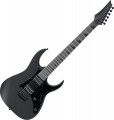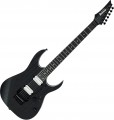Pickups
Type of pickups used in electric guitar.
—
Passive. Passive pickups are called pickups that do not use their own power supply. Such devices produce a weak signal, so guitars with passive pickups require an external preamp. In terms of sound, many musicians consider passive pickups to be more "natural" and dynamic, but this point is largely subjective. The unequivocal advantage of this option is the extensive features for experimenting with the technique of sound extraction. In addition, passive modules are much simpler and cheaper than active modules, and they do not require their own power supplies. On the other hand, these pickups are subject to feedback, which can be problematic in some situations. Yes, and sensitivity to pickups (and, accordingly, the likelihood of interference) they are significantly higher.
—
Active. Pickups supplemented with built-in preamps to increase the level of the signal fed to the output of the instrument. Thanks to the additional amplification, many models have fewer coil turns than passive models, which reduces interference and provides a cleaner and more balanced signal. At the same time, the active module retains the upper frequencies better; this gives the effect of "brightness", "transparency" of the sound. However there is an opinion that this sound turns out to be unnatural, but this moment, again, is largely subjective. But from the unequivocal disad
...vantages of active pickups, one can note the need for their own power source. One of the most popular options for this is a 9V battery, which is installed in a special compartment in the body of the guitar.Coil cutoff
The ability
to disable one of the coils in a humbucking pickup.
Pickups with this feature are, in fact, universal modules that can operate in both humbucking and single-coil modes. See "Pickup Diagram" for details on both. And the ability to switch between these modes allows the musician to change the colour of the sound without resorting to external gadgets or changing instruments. For example, for a dynamic composition with rich overdrive, it is more convenient to use a classic humbucker, and for a slow, lyrical melody, just move the switch and you can enjoy all the advantages of a single-coil.
Pickup switch
A type of pickup switch used on an electric guitar.
This switch is responsible for turning individual pickups on and off, and can also control coil cutoff (see above). Accordingly, the manufacturer chooses its type primarily depending on the number of pickups (see "Pickup Diagram"). So, 3-position switches are typical mainly for models with two pickups — they usually allow you to turn on each of them separately or use both at once. The 5-position controls are common on 3-pickup models with stratocaster or superstrat bodies (see “Shape (Appearance)”). Note that the specific combinations of pickups available in such instruments may be different, this point will not hurt to clarify separately. The most advanced option — a 6-position switch — is extremely rare, mainly in expensive custom class instruments.
A separate type of switch is the balance control, used mainly in bass guitars (see "Type"). They are not responsible for turning off individual pickups (there are usually two of them), but for changing their volume relative to each other. Roughly speaking, these are two volume controls for separate pickups, combined in one knob (of course, there are also two pickups in such instruments). In fact, the balance control in this case also provides a smooth change in timbre: the pickup near the bridge picks up high frequencies better, the pickup near the fretboard picks up lower frequencies, respectively, and the colour of the sound changes depending on which of t...hem sounds louder.
Pickguard
The presence of a protective lining (pickguard) on the body of the guitar.
Such an overlay is located on the upper deck, most often made of durable plastic and differs markedly in colour, due to which it is clearly visible. Its main purpose is to protect the soundboard surface from pick strikes (for example, when playing with dynamic fighting), which could damage the varnished wooden surface. The specific shape and size of the fingerboard may vary, but anyway, it covers at least the surface below the strings (when looking at the guitar in the working position), and sometimes under the strings and even above them.
Material
The material from which the body of an electric guitar is made. For models with cutouts (semi-acoustic, see "Type"), in this case, only the material of the back deck and sides can be taken into account, and data on the top deck is given separately (for more details, see "Deck Cover Material").
Now on the market there are cases of such trees:
red,
maple,
agatis,
ash,
alder.
It makes no sense to dwell on each of the materials found in modern electric guitars. Their variety is very large, however, unlike acoustic guitars, the body in this case does not play such a significant role in shaping the sound, and its material has a relatively small effect on the acoustic properties of the instrument (although the exact degree of such influence is a moot point). If you wish, you can find detailed data on a particular material in special sources, but in fact it makes sense to look primarily at the appearance of the instrument and its price category.
Neck profile
Profile of a fretboard mounted on an electric guitar.
The profile of the neck is called its shape in section, more precisely, the shape of the back of the neck. This parameter practically does not affect the sound of the guitar, but it directly affects the convenience of playing. Ideally, the neck should “fill” the hand, but not be too large — otherwise it will not be possible to clasp it to the right extent.
Profiles are denoted by the letters C, D, V and U — depending on which letter the neck resembles in the section. Profile D is the flattest, C is slightly more convex, with almost uniform curvature along the entire length, U is more voluminous, with a wider profile in the area of the lining, and the V profile in its classic form has the form of an angle with a rounded top. There are also modifications of these options — for example, "thin", which provides for a reduced profile thickness, or "modern", with slightly improved (theoretically) ergonomics.
The most popular profile types are
C,
U and their "modern" (modern) modifications. The C profile is almost semi-circular, the U profile is more voluminous, at the fingerboard its edges are almost parallel and only closer to the back of the neck are sharply rounded. The terms
modern C and
modern U refer to various improved versions of these profiles, their f
...orm may be different.
In fact, the choice of neck profile depends solely on the guitarist's personal preferences, the characteristics of his hands and his preferred playing technique. Thus, there is no "perfect" profile shape — in each case, the optimal choice will be different. The perfect option is to try several types of profile "live", decide which one will be more convenient, and choose an instrument with a neck of the same or similar profile shape.Fretboard radius
The radius of curvature of a fretboard mounted on the fretboard of an electric guitar.
The fingerboard is located directly under the strings, it is to it that the musician presses the strings when playing. If you look at the neck in cross section, its upper part with the overlay will have the shape of an arc; the radius of this arc is implied in this case. The smaller the radius, the more convex this arc will be, and vice versa, a large radius will correspond to an almost flat surface.
In general, it is believed that a smaller fingerboard radius is better for playing chords, and a more even, flat surface makes it easier to play technical passages with an abundance of special techniques such as bands. The average and, one might say, classic diameter value is 12", this is the most popular option among modern electric guitars. The smallest figure is just over 7", it is found in some guitars with Stratocaster bodies (both original Fender instruments and copies ). And the most flat pads have a diameter of 20" or more.
Note that there are often instruments with a variable fretboard radius — smaller at the headstock (where chords are played more often) and larger near the body (where solos are played by notes). In such cases, the radius at the nut is indicated.
Neck material
The material from which the neck of an electric guitar is made.
The most commonly used in the manufacture of the neck is
mahogany.
and
maple. Theoretically, the acoustic properties of an instrument are determined by all its details, and even more so, these properties are affected by the quality of the fretboard. At the same time, we note that this influence is not so strong compared to other characteristics of the guitar (type and number of pickups, scale size, body type, etc.). So in this case, it makes no sense to describe in detail each type of material found in modern instruments — especially since the same term (for example, “mahogany”) can denote different types of wood that differ markedly in working properties and overall quality. When evaluating the material of the neck, it is quite possible to proceed from the fact that the manufacturer selects it in accordance with the price category and the general specialization of the guitar.
Case
The presence of a
case or cover included with the guitar.
Both the case and the case are tool cases, with the difference that cases are made of hard materials and provide better impact protection, while soft cases are more convenient to transport (especially on the shoulders). Anyway, the case is highly desirable for storing and carrying the instrument. It at least protects the guitar from dirt, moisture, temperature extremes, shocks and other adverse effects, and when carrying it, it also provides additional convenience: the design has appropriate devices for this, such as handles or straps. In addition, cases and covers often have additional compartments for accessories (spare strings, picks, notebooks, pedals, etc.)
The presence of a case in the kit saves the musician from having to buy it separately — especially since such an accessory is optimally suited to the "native" model of the guitar. The latter is especially important for custom-shaped cases, for which it can be very difficult to find separately sold cases. At the same time, complete cases / covers may not provide the required degree of protection — often these are the simplest products, designed mainly for warm weather without precipitation. So the characteristics of the complete case will not hurt to clarify separately.

